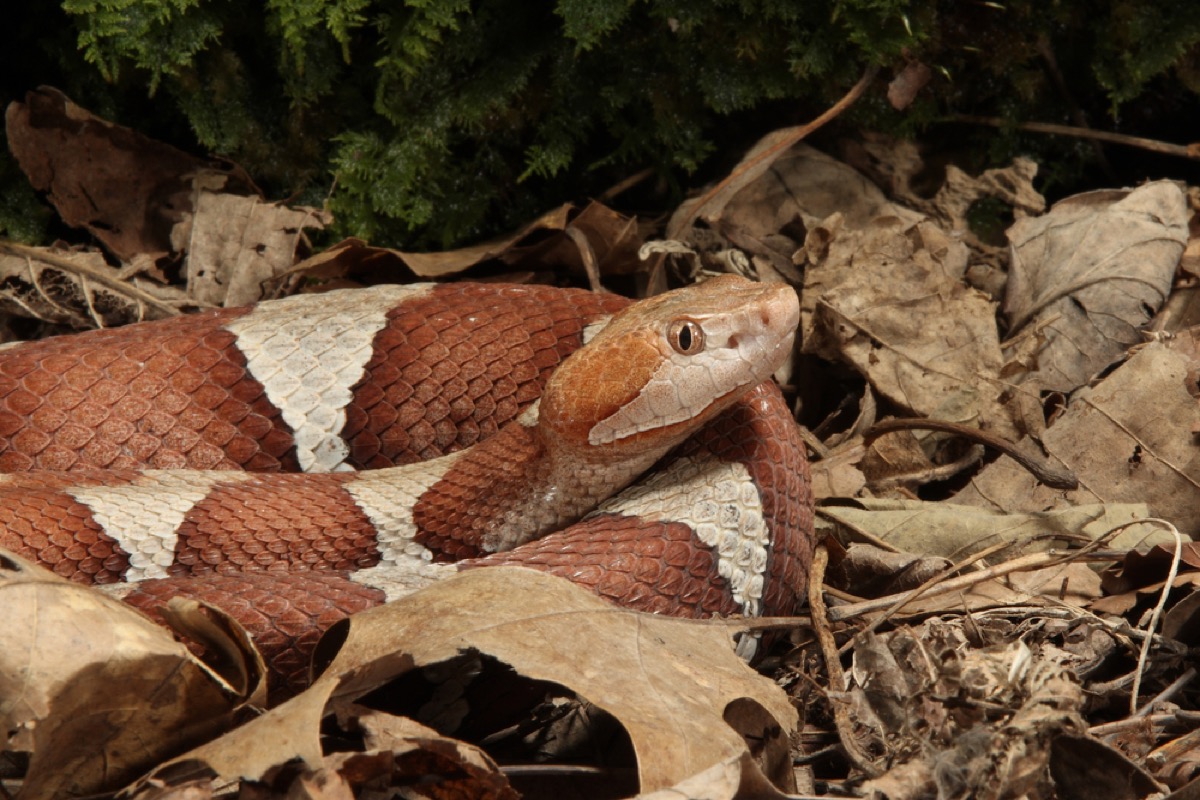The No. 1 Way People Get Snake Bites at Home, Experts Warn

Above anything else, your home should always be a place where you feel safe and at ease. But no matter how well prepared you are, accidents can happen that lead to injuries. Sometimes, it’s related to something you’ve built, like slipping on newly installed tile, burning yourself on a stove or heater, or getting a jolt from a defective socket. But in other cases, your injury could result from something completely unplanned, such as an interaction with an animal—including reptiles. And according to experts, there’s one common way people get snake bites at home. Read on to see what could be putting you in harm’s way.
READ THIS NEXT: How a Snake Can Get Into Your Home Through Your Toilet.
There’s a popular misconception about snakes that can improperly demonize them.

The idea of snakes lurking around your property can make some people uneasy. But the truth of the matter is that the timid creatures tend to be very misunderstood by the general public: Not only do most try to stay out of the way of humans altogether, but they also take on the role of exterminator for common pests.
“Although they can be icky and frightening, most snakes are actually very beneficial to your home’s ecosystem,” Donnie Shelton, owner of Triangle Lawn Care in Raleigh, North Carolina, tells Best Life. “If you notice a garter snake or a king snake, then these can actually be your garden’s biggest ally! Garter snakes eat slugs which can damage your plants, and king snakes will eat rodents as well as kill more dangerous venomous snakes such as copperheads!”
However, when humans and snakes do cross paths, some reptiles will react defensively with a strike. Luckily, the vast majority of snake species in the U.S. aren’t poisonous, and fatal encounters with those that are remain very rare thanks to medical care. According to the Centers for Disease Control and Prevention (CDC), out of the 7,000 to 8,000 venomous snake bites each year, only about five result in death.
Experts warn that most people are bitten by snakes at home when they do one thing.

Whether you’ve found one coiled up beneath your bathroom sink, see one resting near your car in your garage, or notice one hanging out in your garden, encounters with snakes can often come by surprise due to their natural camouflage and timid nature. And while they’re not aggressive to humans, experts warn that you can be putting your safety at risk by attempting to move them from their hiding spot without the proper help.
“The number one way people get bit by a snake at home is by trying to try to catch or kill snakes themselves,” Ray Mitchell of Mitchell Pest Services tells Best Life. “If you see a snake in your home, the best thing to do is to leave it alone and let it go back outside or call a pest control expert!”
RELATED: For more up-to-date information, sign up for our daily newsletter.
Doing work around the house makes you more likely to come across a snake.

Even though finding a snake inside your living space is less common than seeing one outdoors in your yard, you may want to exercise extra caution when doing certain chores. Experts warn that if your property is surrounded by wooded areas or has wetlands or bodies of water nearby, you’re at a potentially higher risk of encountering a reptile.
“Most people wind up with snake bites while working outdoors in their garden or while doing yard work,” Jeremy Griffin from Just Right Lawns in Texas tells Best Life. “They like to hide in tall grass, under decorative rocks or planters, and in other areas such as under tarps or in wood piles. Moving these items without thick leather gloves or rubber boots can lead to snake bites on hands, arms, feet, ankles, and legs because those areas will be closest to the snake.”
Here’s what you should do if a snake bites you.

Even though being careful not to move a snake after discovering them in your home can go a long way in keeping you safe, some encounters are so surprising you may not have a chance to avoid a strike. If any venomous snake ever bites you, you should call 911 and seek medical assistance at a hospital right away, Spencer Greene, director of toxicology at HCA Houston Healthcare-Kingwood in Texas, advises. You should also remove any restrictive clothing or jewelry from the affected area and elevate the extremity above your heart while awaiting treatment.
If you can do so safely, Greene also suggests taking a picture of the snake so experts can identify it to determine which species it is. However, it’s vital to avoid applying any debunked home remedies that could worsen the injury, including tourniquets, “cut and suck” techniques, electrical stimulation, or packing the bitten area in ice, per The Washington Post.
READ THIS NEXT: The No. 1 Sign There’s a Snake in Your Basement.